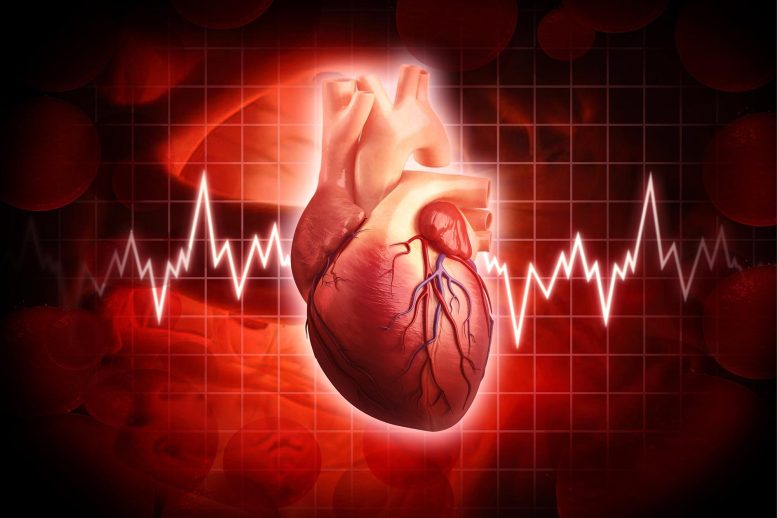
New report outlines the most common symptoms of 6 cardiovascular diseases: heart attack, heart failure, valve disease, stroke, heart rhythm disorders, and peripheral artery and vein disease (PAD and PVD).
New American Heart Association scientific statement indicates symptoms frequently overlap among conditions and may vary by sex.
- A “state of the science” review details the most reported symptoms of 6 cardiovascular diseases (CVDs): heart attack, heart failure, valve disease, stroke, heart rhythm disorders, and peripheral artery and vein disease (PAD and PVD).
- There are important differences in symptoms between women and men.
- Depression, common across many CVDs, may influence a person’s ability to detect changes in symptoms.
- Effective methods of monitoring and measuring symptoms over time are critical to managing cardiovascular disease well and preventing or delaying its progression.
A review of the latest research highlights the most reported symptoms of various cardiovascular diseases (CVDs), noting that men and women often experience different symptoms. This is according to a new American Heart Association scientific statement published today (August 18, 2022) in the Association’s flagship peer-reviewed journal, Circulation.
The statement also highlights how symptoms are experienced over time, which may be months or years apart depending on the condition, and on a spectrum of severity or intensity, noting the long-term nature of cardiovascular disease development. The scientific statement writing committee reviewed current research on the symptoms of different cardiovascular diseases. They found that symptoms vary over time and by sex.
Cardiovascular disease is the leading cause of death in the U.S. and around the world. It comprises several conditions, including 6 reviewed in this scientific statement: heart attack, heart failure, valve disease, stroke, heart rhythm disorders, and peripheral artery and vein disease.
“Symptoms of these cardiovascular diseases can profoundly affect the quality of life, and a clear understanding of them is critical for effective diagnosis and treatment decisions. The scientific statement is a ‘state of the science’ compendium detailing the symptoms associated with CVD, similarities or differences in symptoms among the conditions, and sex differences in symptom presentation and reporting,” said Chair of the scientific statement writing committee Corrine Y. Jurgens, Ph.D., R.N., A.N.P., FAHA, an associate professor at Boston College’s Connell School of Nursing.
Measuring symptoms – what is important?
Due to their subjectivity, measuring symptoms is difficult. Symptoms may go unrecognized or unreported if people don’t think they are important or related to an existing health condition. In addition, symptoms may occur without changes in disease progression, and disease states may also progress without symptoms.
“Some people may not consider symptoms like fatigue, sleep disturbance, weight gain, and depression as important or related to cardiovascular disease,” said Jurgens. “However, research indicates that subtle symptoms such as these may predict acute events and the need for hospitalization. A broader definition of what constitutes an ‘important’ symptom is warranted.”
Some symptoms are common and well-recognized across many types of cardiovascular diseases, while other symptoms are uncommon. For example, chest pain is the most common and recognizable symptom of a heart attack. Less familiar symptoms, however, include shortness of breath, fatigue, sweating, nausea, and lightheadedness.
“Establishing a baseline symptom profile for an individual and tracking symptoms over time may be helpful to detect changes and any progression of symptoms,” Jurgens said.
Heart attack
Heart attack is one of several conditions that falls under the broad category of acute coronary syndrome (ACS), a term that refers to any heart condition caused by sudden loss of blood flow to the heart. The most frequently reported symptom of ACS, particularly heart attack, is chest pain, often described as pressure or discomfort, and it may radiate to the jaw, shoulder, arm, or upper back. The most common co-occurring symptoms are shortness of breath, sweating or a cold sweat, unusual fatigue, nausea, and lightheadedness. These additional symptoms have often been referred to as “atypical,” however, a recent American Heart Association presidential advisory explains that this label may have been due to the lack of women included in the clinical trials from which the symptom lists were derived. Women are more likely than men to report more symptoms in addition to chest pain.
Heart failure
Shortness of breath is a classic symptom of heart failure and a common reason that adults with heart failure seek medical care. However, early, more subtle symptoms should be recognized as signs to consult with a health care professional. These symptoms may include gastrointestinal symptoms such as upset stomach, nausea, vomiting, and loss of appetite; fatigue; exercise intolerance (related to fatigue and shortness of breath); insomnia; pain (chest and otherwise); mood disturbances (primarily depression and anxiety); and cognitive dysfunction (brain fog, memory problems).
Women with heart failure report a wider variety of symptoms, are more likely to have depression and anxiety, and report a lower quality of life compared with men with heart failure. Just like with heart attacks, women are more likely than men to report different symptoms. In heart failure, women report nausea, palpitations, and digestive changes, as well as higher intensity levels of pain (in other areas of the body, not just chest pain), swelling, and sweating.
“Monitoring symptoms on a spectrum, versus present or not present, with reliable and valid measures may enhance clinical care by identifying more quickly those who may be at risk for poor outcomes, such as lower quality of life, hospitalization or death,” Jurgens said. “Ultimately, we have work to do in terms of determining who needs more frequent monitoring or intervention to avert poor heart failure outcomes.”
Valve Disease
Heart valve disease is a common cause of heart failure and shares the symptom of shortness of breath. Problems with heart valves – the leaflet-like structures that control blood flow between the heart’s chambers – include narrowed or stiffened valves (stenosis), valves that close improperly (prolapse), allowing blood to flow backward (regurgitation) or improperly formed valves (atresia). In mild cases of valve disease people may have no symptoms for years, then develop progressively more symptoms similar to those associated with heart failure. Valve disease can also cause high blood pressure in the lungs or pulmonary hypertension. One of the most serious and common forms of valve disease is aortic stenosis, which occurs when the aortic valve narrows and restricts blood flow from the heart.
Women with aortic stenosis more frequently report shortness of breath, exercise intolerance, and physical frailty than men, and they are more likely to have lower scores on a standard classification system for heart failure, known as the New York Heart Association Functional Classification. Men with valve disease are more likely to report chest pain than women with valve disease.
Stroke
A stroke occurs when a blood vessel to the brain is blocked or bursts and typically causes recognizable symptoms that prompt emergency help. To recognize stroke symptoms requiring immediate medical attention, the American Stroke Association recommends everyone remember the acronym F.A.S.T. for Face drooping, Arm weakness, Speech difficulty, Time to call 9-1-1. Other symptoms of stroke are confusion, dizziness, loss of coordination or balance, and visual changes. Recognizing stroke symptoms is critical since immediate treatment may help prevent or reduce the chance of long-term disability or death.
Women experiencing a stroke are more likely than men to have other, less familiar symptoms in addition to the common ones. These symptoms include headache, altered mental state, coma or stupor. A stroke may also impair thinking, which may, in turn, impact the individual’s ability to recognize new or worsening symptoms.
After a stroke, some symptoms may linger and require continued care whether these symptoms require rehabilitation or become disabilities. Post-stroke screening should include assessment for anxiety, depression, fatigue, and pain. Post-stroke pain may take months to develop, with most reports occurring at 4–6 months after a stroke.
Rhythm Disorders
Rhythm disorders, called arrhythmias, are often described as the feeling of an abnormal heartbeat or palpitations that may be irregular, fast, fluttering, or halting. Other symptoms include fatigue, shortness of breath, and dizziness, all of which are shared with other cardiovascular diseases. Less commonly, chest pain, dizziness, fainting or nearly fainting, and anxiety may occur in some people with heart rhythm disorders.
Women and younger adults with rhythm disorders are more likely to experience palpitations, while men are more likely to experience no symptoms. Older adults are more likely to experience either uncommon symptoms or no symptoms. Differences in symptoms have also been found among people from diverse racial and ethnic groups. Data indicate Black adults report experiencing more palpitations, shortness of breath, exercise intolerance, dizziness, and chest discomfort in comparison to people who are Hispanic or white.
Vein and Artery disease
Peripheral artery disease, or PAD, affects the arteries in the lower extremities leading to reduced blood supply to the legs. People with PAD may have no symptoms or may develop the classic symptom of claudication, which is pain in one or both calf muscles that occurs while walking and subsides with rest. However, pain in other parts of the legs and in the feet and toes are the most common symptoms of PAD rather than calf pain. PAD with symptoms is associated with an increased risk for heart attack and stroke, with men at higher risk than women.
“Measuring vascular symptoms includes assessing quality of life and activity limitations, as well as the psychological impact of the disease,” said Jurgens. “However, existing measures are often based on the clinician’s appraisal rather than the individual’s self-reported symptoms and severity of symptoms.”
Depression occurs frequently among people with PAD, especially women and people who are elderly or from diverse racial and ethnic groups. Depression is also more likely to occur among people with more severe PAD.
Peripheral vein disease (PVD), like PAD, may cause no symptoms, or it may cause leg pain. Typical leg-related symptoms include leg pain and achiness, heaviness or tightness in the legs, fatigue, cramping, restless legs syndrome, and skin irritation. In one study, adults younger than age 65 were more likely than older adults to report pain, heaviness, achiness, and fatigue. Symptoms of vein disease sometimes occur even when there are no visible signs of the condition.
Sex differences in vein and artery disease are mainly seen among those with PAD. Women are more likely to report pain in other places than the calf muscle or no symptoms at all. Women’s symptoms are often complicated by the mistaken belief that PAD is more common among men or the symptoms are confused with those of other common conditions such as osteoarthritis. PAD is also more likely to progress quickly in women and affect quality of life.
Other factors that influence symptoms
National survey data shows that people with cardiac disease have about twice the rate of depression compared to people without any medical condition (10% vs. 5%). A 2014 American Heart Association scientific statement suggested depression should be considered a risk factor for worse outcomes after an acute coronary syndrome event or diagnosis.
The current statement highlights that people with persistent chest pain, people with heart failure, as well as stroke survivors and people with peripheral artery disease commonly have depression and/or anxiety. In addition, cognitive changes after a stroke may affect how and whether symptoms are experienced or noticed. The writing group advises regular assessments of cognitive function and depression levels throughout the course of any cardiovascular disease because they have a strong influence on a person’s ability to detect symptoms and any changes in their condition.
“Symptom relief is an important part of managing cardiovascular disease,” said Jurgens. “It is important to recognize that many symptoms vary in occurrence or severity over time, that women and men often experience symptoms differently, and factors such as depression and cognitive function may affect symptom detection and reporting. Monitoring and measuring symptoms with tools that appropriately account for depression and cognitive function may help to improve patient care by identifying more quickly people who may be at higher risk.”
Reference: “State of the Science: The Relevance of Symptoms in Cardiovascular Disease and Research: A Scientific Statement From the American Heart Association” by Corrine Y. Jurgens, Christopher S. Lee, Dawn M. Aycock, Ruth Masterson Creber, Quin E. Denfeld, Holli A. DeVon, Linda R. Evers, Miyeon Jung, Gianluca Pucciarelli, Megan M. Streur, Marvin A. Konstam and on behalf of the American Heart Association Council on Cardiovascular and Stroke Nursing; Council on Hypertension; and Stroke Council, 18 August 2022, Circulation.
DOI: 10.1161/CIR.0000000000001089
Co-authors and member of the writing committee are Vice Chair Christopher S. Lee, Ph.D., R.N., FAHA; Dawn M. Aycock, Ph.D., R.N., A.N.P.-B.C., FAHA; Ruth Masterson Creber, Ph.D., M.Sc., R.N., FAHA; Quin E. Denfeld, Ph.D., R.N., FAHA; Holli A. DeVon, Ph.D., R.N., FAHA; Linda R. Evers, J.D.; Miyeon Jung, Ph.D., R.N., FAHA; Gianluca Pucciarelli, Ph.D., R.N., FAHA; Megan M. Streur, Ph.D., R.N., F.N.P.; and Marvin A. Konstam, M.D., FAHA. Authors’ disclosures are listed in the manuscript.
This scientific statement was prepared by the volunteer writing group on behalf of the American Heart Association’s Council on Cardiovascular and Stroke Nursing; the Council on Hypertension; and the Stroke Council. American Heart Association scientific statements promote greater awareness about cardiovascular diseases and stroke issues and help facilitate informed health care decisions. Scientific statements outline what is currently known about a topic and what areas need additional research. While scientific statements inform the development of guidelines, they do not make treatment recommendations. American Heart Association guidelines provide the Association’s official clinical practice recommendations.









Wonderful information
Major contributor to heart problems
Now are the covid vaccines
Any of you liberal dumbasses who believe the so-called COVID vaccine including the “boosters” got whatever brain you have so far up the Demoncrats brainless mentality are part of this country’s downfall.
Thanks to you, America has become a 3rd world country. Go F yourself.
RS is a well known moron.
RS must stand for real stupid.
So, based on the information given in this article, everyone has CVD.
So wait. Now’s there’s a difference between men and women?
I am a female,38yrs old and walked in the Emergency room thinking I had a UTI. It was actually a heart attack happening. I had no idea I was having a heart attack. Thank God for the Cardiologist in the ER that night! Or I might not be here.
Bada bing bada boom
no comment
Well I’m 55 years old and they haven’t done nothing for me yet I’ve had all these symptoms on everything all they done is run me to the hospital for two tests come back to know everything looks fine but you got these problems going on if they get worse go to the ER.
@RS quit your republicon lies please. There is no proof that covid vaccines are a major factor for heart problems. The only proof you have are other magacucks lying their assess off.
I was recently in the ER for a kidney stone where there found I had an ascending thoracic aortic aneurysm 4.5cm when I went to see my gp she said we’ll take a look at it again in 6 months, shouldn’t I be sent to some sort of specialist?
Nailed it ES…of course these Biden/Foolchie clowns running around with heads up their asses.Keep ignoring facts chumps.
Anything BUT the experimental injection
Well covid shoot now has a friend can’t work can got to gym mow lawn it has his heart so week and it all happened three days after his shot so the covid shoot is a case to another people just can’t open there eyes
I’m 31 a male and have been recreational IV drug user because I was roughly about 20, it wasn’t my main R.O.A, honestly I bounced back and forth between snorting smoking and IV. My D.O.C was an unfortunately is any kind of opiate I didn’t get my hands on including but not limited to heroin fentanyl oxys as well as methamphetamine. Before fentanyl came on to the market I would mix meth and heroin together in the same syringe that was honestly my preference. But some days but have one and not the other and vice versa what I’m getting at is about a year ago I started getting a sharp pain in outside my right leg just above my knee. It wasn’t constant it was every now and then when I’d be sitting stationary for extended periods of time. Then over time the pain started shooting up the outside of my thigh up to my hip and this would happen periodically, but now as of late it’s become somewhat of a constant pain in between my knee and hip on the outside of my thigh. It’s a similar feeling to your leg “falling asleep”just more intense. Some days it would cause excruciating pain to wear pulling up my pants I would have to make an extra effort to not allow my elastic waistband from my boxers to have contact with my thigh as I pulled them up as it would hurt just on the surface though overtime the pain has settle down a little bit but every now and then it flares up and I get that burning sensation want to do any type of jumping running or any fast motion to a sudden stop if that makes any sense. Any idea what it would be? Obviously I know the IV use but specifically what would it identified as, me early stages of P.A.D ..?please keep all the nonsense and s*** talking comments to yourself please.
Mike, pinched nerve?
Only way to know for sure is go to doctor tell them your symptoms and hope they listen and order the right tests for you.
Hi mike, I had similar symptoms and my doctor said it was a pinched nerve in my lower back and is very common among overweight people. When I lost weight it went away. If you are on the thinner side I would definitely see a doctor though. I am also an IV user and I was told by doctor that infection in the valves leading into the heart is common and and often fatal among IV users. So please use clean needles to prevent that from happening.
Shae & Off Kilter, I would get 2nd opinion, many specialists no longer require referrals…
Any of you liberal dumbasses who believe the so-called COVID vaccine including the “boosters” got whatever brain you have so far up the Demoncrats brainless mentality are part of this country’s downfall.
Thanks to you, America has become a 3rd world country. Go F yourself.
Bigger issue is fast food, processed food, high sodium intakes combined with unnecessary fat intakes. This is a big problem in America, leads to high blood pressure and cholesterol. But yet we’re more worried about some vaccines that saved a few million lives…..
Yes we have a stroke survivor and I am a cancer survivor yes may be back to backyard oh the standard of living became too low but just a second miracles will be in my way…
Chagas Disease Negligence Awareness 🆘️ 🇺🇸
This is to “anonymous”. You are so scared, you won’t even publish your name. Democrats are awesome. Covid is real. Now, go get upset again Dumbass.
Hi Off Kilter, my father had an abdominal aortic aneurysm and his doctor told him same thing, that they would watch it. He ended up needing surgery for it 3 months later. The surgery went really well and he lived many years after.
If you’re not comfortable waiting 6 months tell your doctor and see if the doctor will monitor it sooner.
Hi Mike, it’s Fluffy again. A pinched nerve can cause a burning feeling and can make your skin super sensitive (since nerves go to the skin too). I know cause I’ve had one and you can have a pinched nerve if you’re not overweight. But like i said you should tell your doctor, there are nerve conduction tests that can be done to see if you have a nerve issue also mri test can show if you have a problem in your spine that could be causing nerve issue.
Don’t pay attention to the political nonsense here. Good luck.